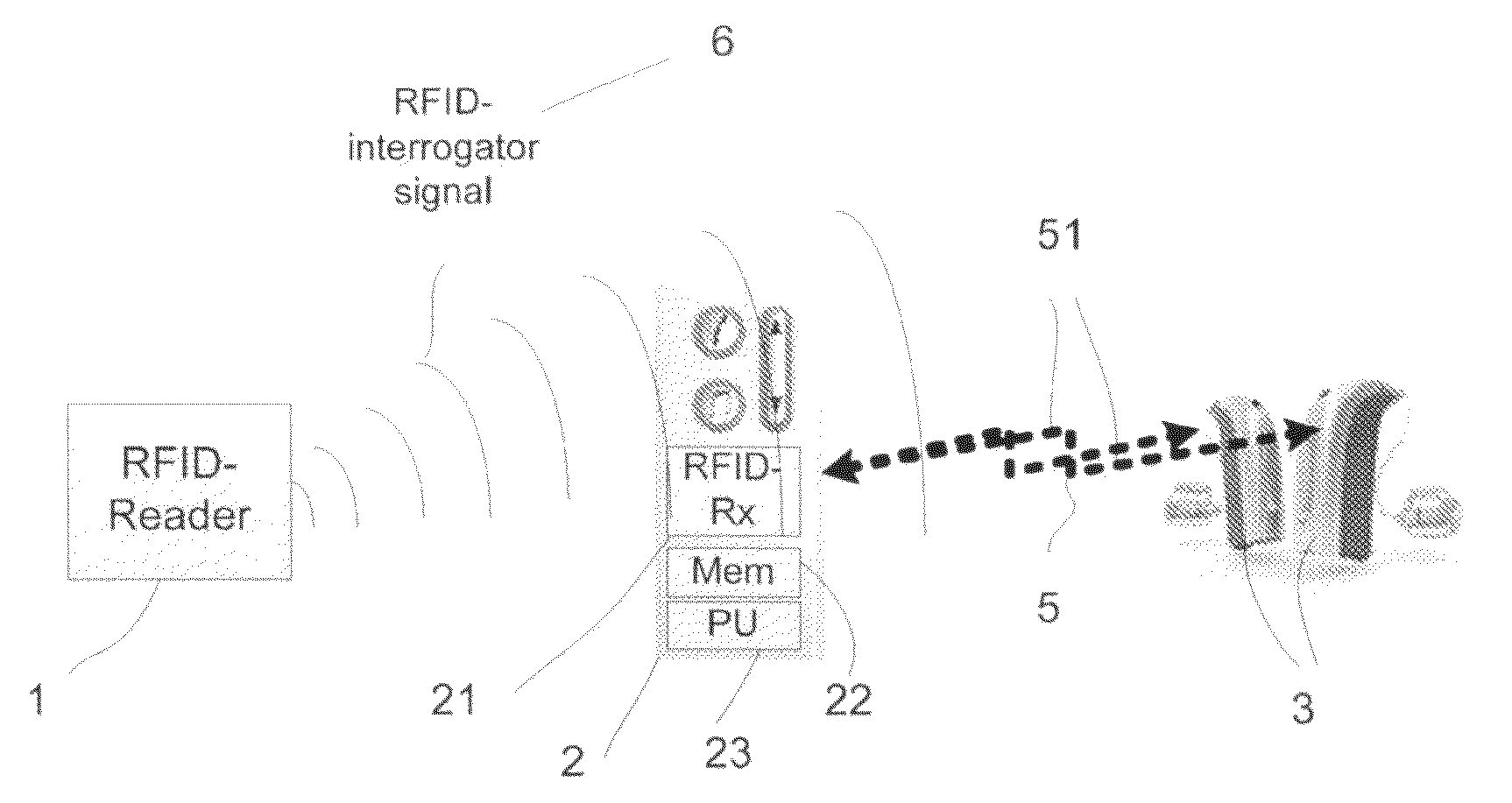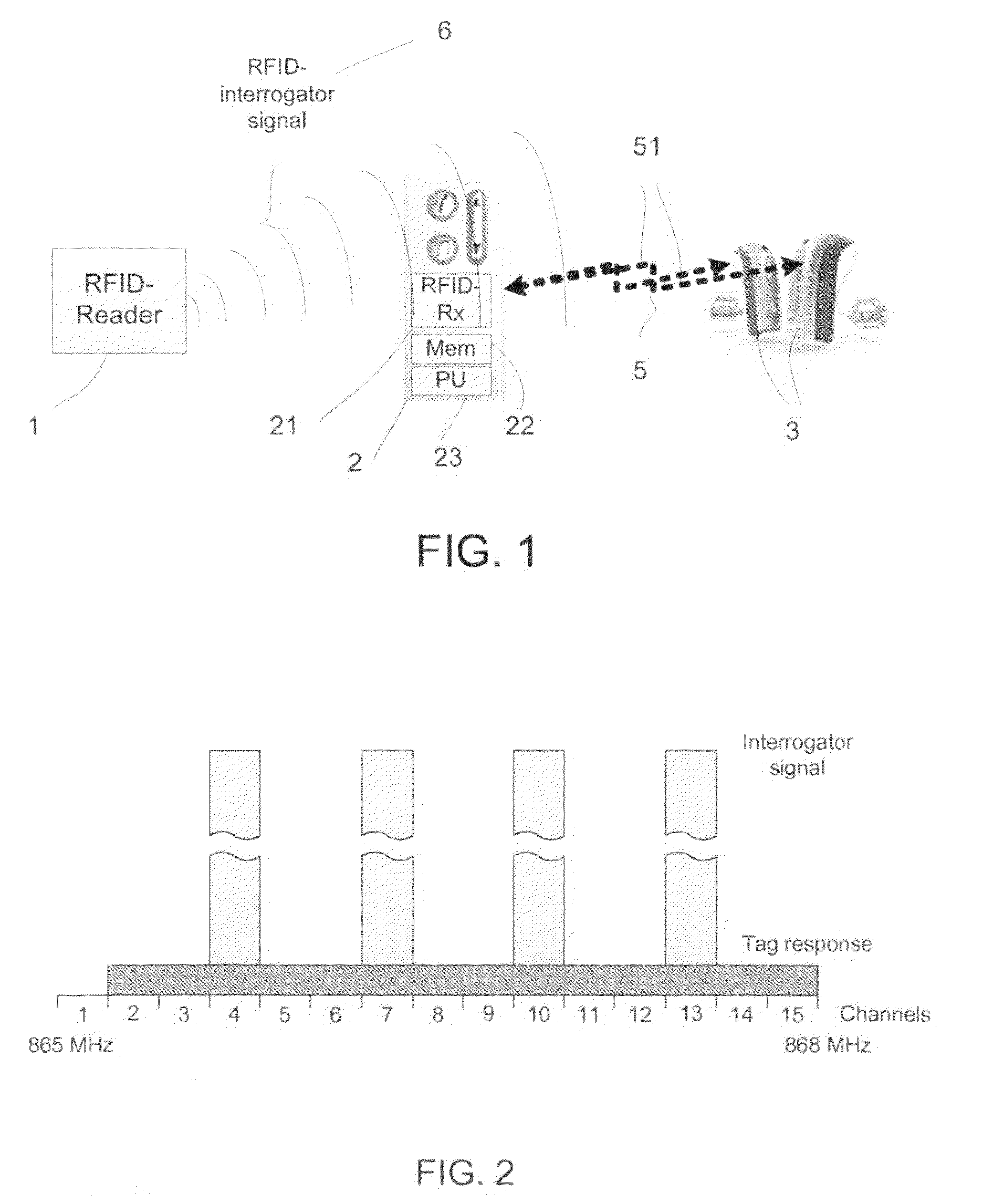Embedded RFID recorder in short-range wireless devices
a wireless device and rfid technology, applied in the direction of electrical equipment, network planning, indirect connection of subscribers, etc., can solve the problems of not being able to agree on how to share the usage in time or shift channels, and not being able to achieve such a spectrally efficient operation, etc., to achieve efficient spectrum usage, improve spectrum sharing, and simple scheme of extracting
- Summary
- Abstract
- Description
- Claims
- Application Information
AI Technical Summary
Benefits of technology
Problems solved by technology
Method used
Image
Examples
example , use 1
Example, Use 1
[0087]Interference-risk=f(channels used). The SRD checks the log file of the embedded tag and, if it detects that a valid signal from a RFID reader appears, then it suppresses the usage of the channels 3, 5, 7, 9 (these channels (here) being allocated to RFID-readers, RFID ch. 1 to RFID ch. 4 in FIG. 3, 4). This means that the SRD has entered into a location where RFID readers are deployed and there is a high chance to experience interference at these channels. After suppressing these channels, the SRD again monitors the log file of the embedded RFID tag. If, during a certain period of time (e.g. 1 or 2 minutes) no valid RFID reader signal is detected, that means that the SRD is outside the interfering zone of the RFID reader and it can again use the channels 3, 5, 7, 9. This simple usage can have implications on the future regulations. Namely, with the embedded RFID tag a SRD can successfully detect presence / absence of a RFID system in its close proximity and, in the ...
example use 1
[0095]If the reader broadcasts the code of the country in which it is situated (e.g. at the border-crossing), then the SRD can employ the spectrum usage rules that are intended for that country, cf. e.g. FIG. 6e. The country code scheme used can be any appropriate unique identification of the country (or federal state or other geographical area having its own spectrum usage). One example could be the ISO 3166-1 scheme as specified by the International Organization for Standardization. Another could be the national dialling codes as specified by the International Telecommunication Union (ITU).
example use 2
[0096]The novel paradigm in spectrum regulation is the dynamic spectrum access, which is expected to get a momentum in the coming years. In short, in the dynamic spectrum access the frequency bands are not simply divided into licensed (like the GSM spectrum) or unlicensed (like the UHF 865-868 MHz or the 2.4 GHz ISM band), but there will be other models of spectrum usage—temporary renting, usage with guaranteed interference, etc. In all these scenarios, it is of crucial importance that the radio devices that are capable of dynamic spectrum access can learn their radio environment—i.e. which channels can be used in a given location and given time, etc. (cf. e.g. FIG. 6f). Such a relevant spectrum information can be locally advertised by RFID readers and, upon detection of such an RFID signal by the embedded RFID tag, the device can get the relevant knowledge for the dynamic spectrum access (e.g. that a certain channel X is available for use in the next 2 hours). Clearly, such an RFID...
PUM
 Login to View More
Login to View More Abstract
Description
Claims
Application Information
 Login to View More
Login to View More - R&D
- Intellectual Property
- Life Sciences
- Materials
- Tech Scout
- Unparalleled Data Quality
- Higher Quality Content
- 60% Fewer Hallucinations
Browse by: Latest US Patents, China's latest patents, Technical Efficacy Thesaurus, Application Domain, Technology Topic, Popular Technical Reports.
© 2025 PatSnap. All rights reserved.Legal|Privacy policy|Modern Slavery Act Transparency Statement|Sitemap|About US| Contact US: help@patsnap.com



